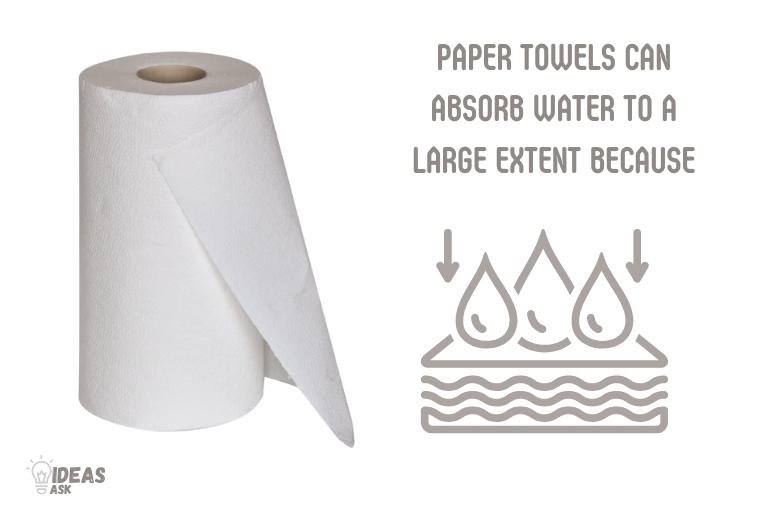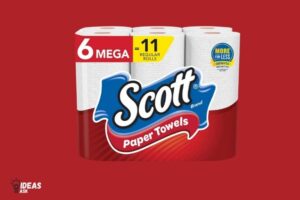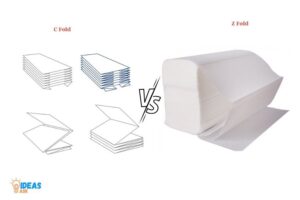Paper Towels Can Absorb Water to a Large Extent Because:
Paper towels can absorb water to a large extent because of their physical structure and the properties of their materials.
They are made up of cellulose fibers which are hydrophilic, meaning they attract water molecules. The spaces within the fibers also help to trap and hold water, making paper towels highly absorbent.
Cellulose fibers found in paper towels are long and intertwined, forming a network of small spaces. Water molecules are attracted to cellulose, due to their polar nature.
When a paper towel comes in contact with water, these molecules are drawn into the spaces within the fibers, leading to absorption. This phenomenon is enhanced by the capillary effect, where water can move up against gravity in narrow spaces.
The cellulose fibers and their interwoven network structure create spaces that trap and hold water molecules. This combined with the capillary effect and hydrophilic nature of cellulose, allows paper towels to effectively absorb large amounts of water.

Key Takeaway
The Science Behind Paper Towel Absorbency
Paper towels are a common item found in households globally. Their primary function is to clean up spills and messes around the house.
But, have you ever wondered how they are so absorbent? This section of the blog post will delve into the science behind paper towel absorbency, focusing on the role of capillary action and hydrogen bonding.
Explain The Science Behind How Paper Towels Absorb Water
Paper towels are made up of cellulose fibres. These fibres contain millions of tiny spaces between them, which allow the paper towel to hold and retain water. The science behind how paper towels absorb water lies in capillary action and hydrogen bonding.
Discuss The Role Of Capillary Action And Hydrogen Bonding In Paper Towel Absorbency
Capillary action refers to the ability of water to move against gravity through a narrow space. When a paper towel touches a wet surface, capillary action occurs, and the water is drawn into the tiny spaces between the cellulose fibres.
As a result, the water gets evenly distributed throughout the paper towel, making it an effective tool for cleaning up spills.
Hydrogen bonding is the force that holds water molecules together. When water molecules come into contact with the cellulose fibres of a paper towel, they form hydrogen bonds, which allows the paper towel to hold onto the water.
This is because the cellulose fibres in the paper towel are polar, and the water molecules are attracted to them. The science behind paper towel absorbency lies in the capillary action and hydrogen bonding that occurs between the water molecules and the cellulose fibres.
Understanding the science behind paper towel absorbency will allow you to appreciate this common household item even more.
Factors That Affect Paper Towel Absorbency
Paper towels are widely used in households and businesses because they are an affordable and convenient way to clean up spills.
But have you ever wondered how these towels can absorb water so well? We will discuss the factors that affect the absorbency of paper towels, including ply, embossing, texture, and size.
We will explain the difference between high-quality and low-quality paper towels in terms of absorbency.
Discuss Various Factors That Affect The Absorbency Of Paper Towels
- Ply: The number of plies in a paper towel affects its absorbency. The more plies a paper towel has, the better it can absorb water.
- Embossing: The patterns on the paper towel’s surface, known as embossing, can increase its absorbency by creating more surface area to soak up water.
- Texture: Rough or textured paper towels have more crevices, which allow them to capture and hold more water than smoother towels.
- Size: Generally, larger paper towels can absorb more water than smaller ones due to their increased surface area.
Explain The Difference Between High-Quality And Low-Quality Paper Towels In Terms Of Absorbency
High-quality paper towels are generally more absorbent than their low-quality counterparts due to several factors, such as:
- More plies, which increase their absorbency and make them thicker and more durable
- A higher-quality embossing process, which creates deeper patterns that are better at capturing moisture
- A softer texture that allows them to conform to surfaces and capture water more efficiently
Low-quality paper towels, on the other hand, may be more affordable, but they are often less absorbent due to:
- Fewer plies, resulting in a thinner, less absorbent towel
- A lower-quality embossing process that creates shallower patterns and is less effective at capturing moisture
- A coarser texture that does not conform to surfaces as well and is not as efficient at capturing water
Paper towel absorbency is affected by many factors, including ply, embossing, texture, and size.
High-quality paper towels are generally more absorbent due to their thicker, softer, and better-embossed design, while low-quality paper towels are less absorbent because they lack these features.
When choosing paper towels, it’s essential to consider the type of tasks they will be used for and the absorbency needed to ensure optimal performance.
Alternative Uses For Paper Towels
Paper Towels Can Absorb Water To A Large Extent Because
Paper towels are commonly known for their ability to absorb water and clean up spills. But have you ever wondered why they are so effective? Well, the answer lies in their composition. They are made of 100% cellulose fibers that are loosely woven together.
This allows them to create capillary spaces between the fibers, which act like tiny sponges and suck up water.
Gardening:
Paper towels can be a useful tool in the garden, especially for germinating seeds and propagating plants.
Here are some ways you can use paper towels in gardening:
- Germinating seeds: You can use paper towels to germinate seeds by placing them on a moist paper towel and keeping it in a plastic bag. This creates a mini greenhouse and encourages germination.
- Propagating plants: Paper towels can be used to propagate plants by taking cuttings, wrapping them in a moist paper towel, and placing them in a plastic bag until the roots start to grow.
Arts And Crafts:
Paper towels are also great for arts and crafts projects. Their absorbency and texture make them ideal for a range of creative activities.
Here are some ways you can use paper towels in arts and crafts:
- Painting: Use paper towels to blot or dab paints, or to create textured patterns.
- Collage: Tear or cut paper towels into interesting shapes, and use them in collage projects.
- Paper mache: Use paper towels as a base for paper mache, or to add texture to paper mache sculptures.
Hygiene:
Paper towels can also be used for personal hygiene, especially when traveling or when water is not readily available.
Here are some ways you can use paper towels for personal hygiene:
- Hand drying: Use paper towels to dry your hands when hand dryers are not available.
- Makeup removal: Use paper towels to remove makeup, or to blot excess oil from your skin.
- Baby care: Use paper towels as wipes for babies, or to clean up spills and messes on the go.
Advise On Eco-Friendly Alternatives To Disposable Paper Towels
While paper towels are convenient, their disposable nature makes them incredibly wasteful. Luckily, there are eco-friendly alternatives that you can use instead.
Here are a few options:
- Reusable cloth towels: Swap out paper towels for reusable cloth towels made from natural materials like cotton or bamboo. These can be washed and reused multiple times, reducing waste.
- Compostable wipes: Look for compostable wipes made from eco-friendly materials that can be discarded in a compost bin.
- Air dry: Consider air drying your hands instead of using paper towels.
While paper towels may primarily be used for cleaning up spills, they have a wide range of versatile uses from gardening to personal hygiene.
With eco-friendly alternatives available, it’s important to consider the impact of disposable paper towels on the planet and explore more sustainable options.
Conclusion
Incorporating paper towels into our daily routines is often overlooked, but it turns out to be an essential component. From cleaning spills to drying surfaces, paper towels are versatile, convenient and efficient.
One of the reasons these towels are highly effective in absorbing moisture is because of their composition.
Made from processed wood fibers, paper towels have small empty spaces in between the fibers that allow for enhanced water absorption, and this can be attributed to capillary action and hydrogen bonding.
In addition, the creping process involved in manufacturing paper towels increases the surface area, and hence, there is more space to absorb water. The high surface tension of water enables it to travel through the paper towel fibers and occupy the spaces between them.
The mass production of paper towels makes them inexpensive and readily accessible. Paper towels are a necessary component in our daily lives because of their superior ability to absorb water.




